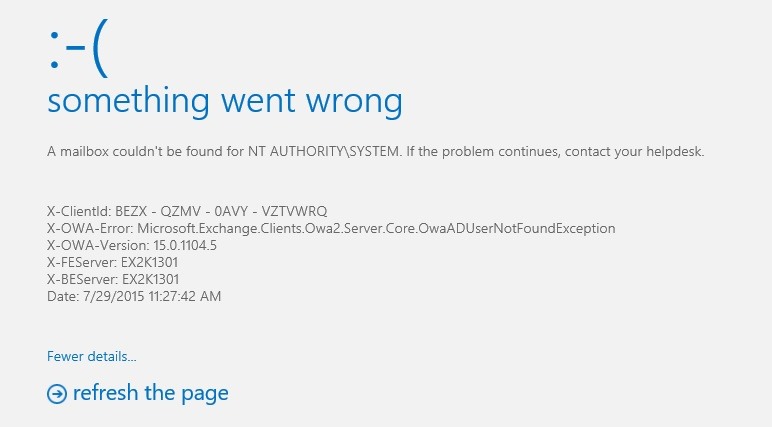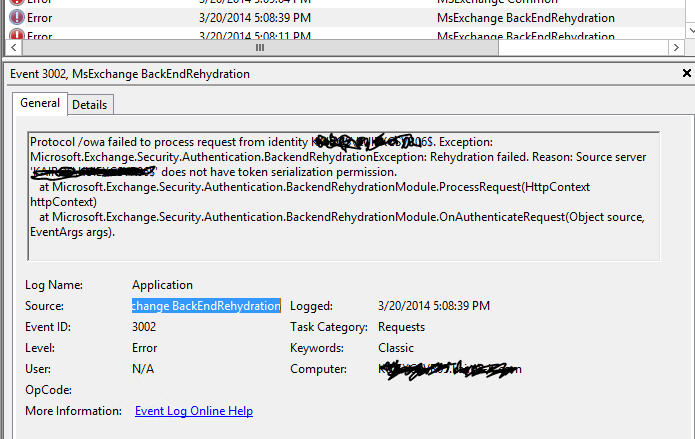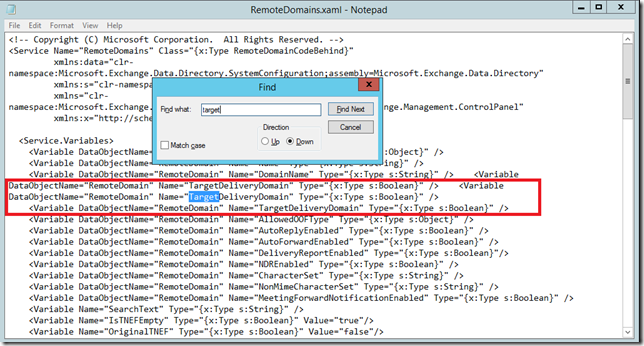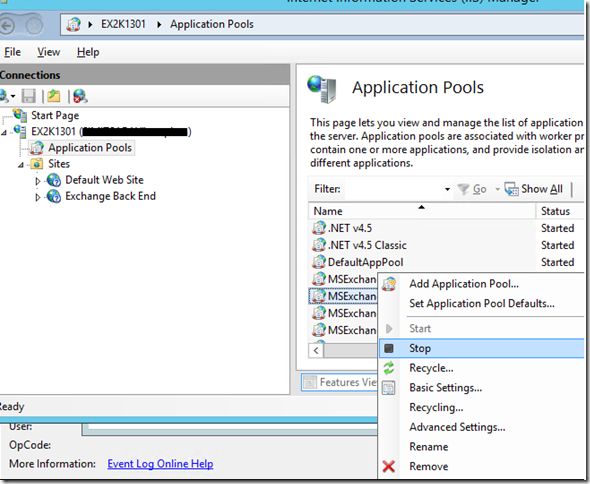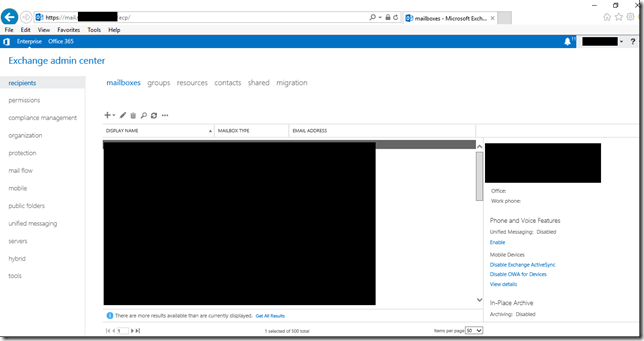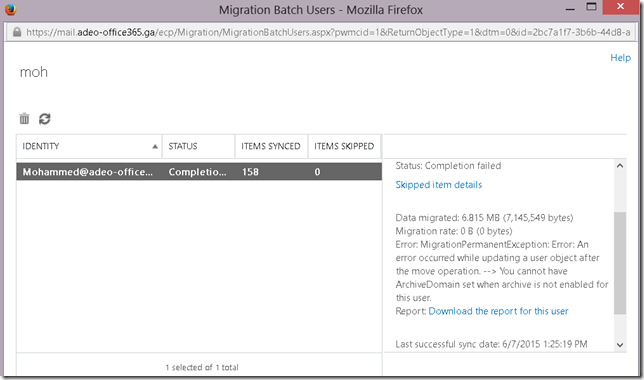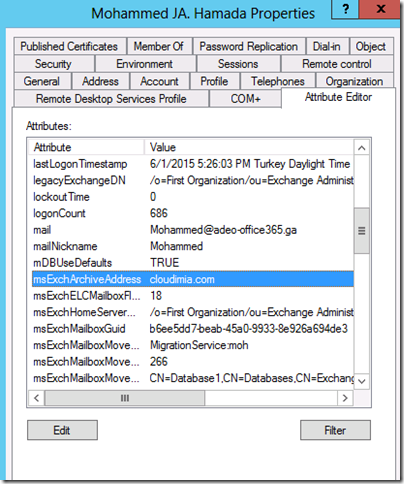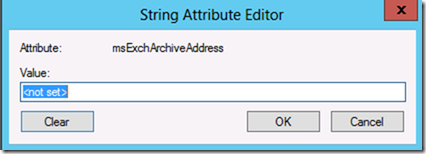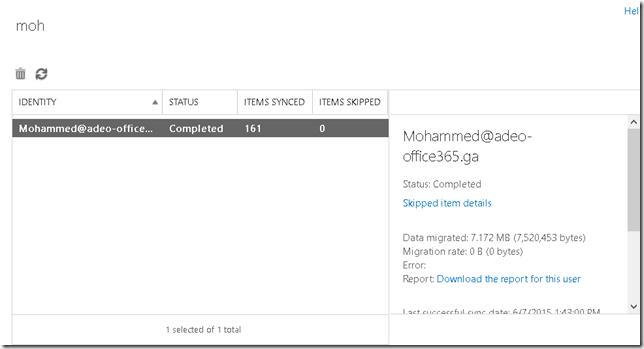Current user: 'Domain.local/User'
Request for URL 'https://ex2k1301.Domain.local:444/ecp/default.aspx(https://mail.Domain.com/ecp/)' failed with the following error:
System.Web.HttpUnhandledException (0x80004005): Exception of type 'System.Web.HttpUnhandledException' was thrown. ---> System.Reflection.TargetInvocationException: Exception has been thrown by the target of an invocation. ---> System.Data.DuplicateNameException: A column named 'TargetDeliveryDomain' already belongs to this DataTable.
at System.Data.DataColumnCollection.RegisterColumnName(String name, DataColumn column)
at System.Data.DataColumnCollection.BaseAdd(DataColumn column)
at System.Data.DataColumnCollection.AddAt(Int32 index, DataColumn column)
at Microsoft.Exchange.Management.DDIService.AutomatedDataHandlerBase.CreateColumn(DataTable table, Dictionary`2 rbacMetaData)
at Microsoft.Exchange.Management.DDIService.AutomatedDataHandlerBase..ctor(Service profileBuilder)
at Microsoft.Exchange.Management.DDIService.AutomatedDataHandlerBase..ctor(String schemaFilesInstallPath, String schema)
at Microsoft.Exchange.Management.DDIService.WSListDataHandler..ctor(String schemaFilesInstallPath, String resourceName, String workflowName, DDIParameters parameters, SortOptions sortOptions)
at Microsoft.Exchange.Management.DDIService.DDIServiceHelper.GetListCommon(DDIParameters filter, SortOptions sort, Boolean forGetProgress)
--- End of inner exception stack trace ---
at System.RuntimeMethodHandle.InvokeMethod(Object target, Object[] arguments, Signature sig, Boolean constructor)
at System.Reflection.RuntimeMethodInfo.UnsafeInvokeInternal(Object obj, Object[] parameters, Object[] arguments)
at System.Reflection.RuntimeMethodInfo.Invoke(Object obj, BindingFlags invokeAttr, Binder binder, Object[] parameters, CultureInfo culture)
at Microsoft.Exchange.Management.ControlPanel.WebServiceReference.GetList(DDIParameters filter, SortOptions sort)
at Microsoft.Exchange.Management.ControlPanel.OrganizationCache.LoadTargetDeliveryDomain(AddValueHandler addValue, LogErrorHandler logError)
at Microsoft.Exchange.Management.ControlPanel.OrganizationCache.TryGetValue[T](String key, T& value)
at Microsoft.Exchange.Management.ControlPanel._Default.RenderMetroTopNav()
at ASP.default_aspx.__RendermainForm(HtmlTextWriter __w, Control parameterContainer)
at System.Web.UI.Control.RenderChildrenInternal(HtmlTextWriter writer, ICollection children)
at System.Web.UI.HtmlControls.HtmlForm.RenderChildren(HtmlTextWriter writer)
at System.Web.UI.HtmlControls.HtmlContainerControl.Render(HtmlTextWriter writer)
at System.Web.UI.Control.RenderControlInternal(HtmlTextWriter writer, ControlAdapter adapter)
at ASP.default_aspx.__Render__control1(HtmlTextWriter __w, Control parameterContainer)
at System.Web.UI.Control.RenderChildrenInternal(HtmlTextWriter writer, ICollection children)
at System.Web.UI.Page.Render(HtmlTextWriter writer)
at System.Web.UI.Control.RenderControlInternal(HtmlTextWriter writer, ControlAdapter adapter)
at System.Web.UI.Page.ProcessRequestMain(Boolean includeStagesBeforeAsyncPoint, Boolean includeStagesAfterAsyncPoint)
at System.Web.UI.Page.HandleError(Exception e)
at System.Web.UI.Page.ProcessRequestMain(Boolean includeStagesBeforeAsyncPoint, Boolean includeStagesAfterAsyncPoint)
at System.Web.UI.Page.ProcessRequest(Boolean includeStagesBeforeAsyncPoint, Boolean includeStagesAfterAsyncPoint)
at System.Web.UI.Page.ProcessRequest()
at System.Web.UI.Page.ProcessRequest(HttpContext context)
at System.Web.HttpApplication.CallHandlerExecutionStep.System.Web.HttpApplication.IExecutionStep.Execute()
at System.Web.HttpApplication.ExecuteStep(IExecutionStep step, Boolean& completedSynchronously)
at System.Web.UI.Page.HandleError(Exception e)
at System.Web.UI.Page.ProcessRequestMain(Boolean includeStagesBeforeAsyncPoint, Boolean includeStagesAfterAsyncPoint)
at System.Web.UI.Page.ProcessRequest(Boolean includeStagesBeforeAsyncPoint, Boolean includeStagesAfterAsyncPoint)
at System.Web.UI.Page.ProcessRequest()
at System.Web.UI.Page.ProcessRequest(HttpContext context)
at System.Web.HttpApplication.CallHandlerExecutionStep.System.Web.HttpApplication.IExecutionStep.Execute()
at System.Web.HttpApplication.ExecuteStep(IExecutionStep step, Boolean& completedSynchronously)
System.Reflection.TargetInvocationException: Exception has been thrown by the target of an invocation. ---> System.Data.DuplicateNameException: A column named 'TargetDeliveryDomain' already belongs to this DataTable.
at System.Data.DataColumnCollection.RegisterColumnName(String name, DataColumn column)
at System.Data.DataColumnCollection.BaseAdd(DataColumn column)
at System.Data.DataColumnCollection.AddAt(Int32 index, DataColumn column)
at Microsoft.Exchange.Management.DDIService.AutomatedDataHandlerBase.CreateColumn(DataTable table, Dictionary`2 rbacMetaData)
at Microsoft.Exchange.Management.DDIService.AutomatedDataHandlerBase..ctor(Service profileBuilder)
at Microsoft.Exchange.Management.DDIService.AutomatedDataHandlerBase..ctor(String schemaFilesInstallPath, String schema)
at Microsoft.Exchange.Management.DDIService.WSListDataHandler..ctor(String schemaFilesInstallPath, String resourceName, String workflowName, DDIParameters parameters, SortOptions sortOptions)
at Microsoft.Exchange.Management.DDIService.DDIServiceHelper.GetListCommon(DDIParameters filter, SortOptions sort, Boolean forGetProgress)
--- End of inner exception stack trace ---
at System.RuntimeMethodHandle.InvokeMethod(Object target, Object[] arguments, Signature sig, Boolean constructor)
at System.Reflection.RuntimeMethodInfo.UnsafeInvokeInternal(Object obj, Object[] parameters, Object[] arguments)
at System.Reflection.RuntimeMethodInfo.Invoke(Object obj, BindingFlags invokeAttr, Binder binder, Object[] parameters, CultureInfo culture)
at Microsoft.Exchange.Management.ControlPanel.WebServiceReference.GetList(DDIParameters filter, SortOptions sort)
at Microsoft.Exchange.Management.ControlPanel.OrganizationCache.LoadTargetDeliveryDomain(AddValueHandler addValue, LogErrorHandler logError)
at Microsoft.Exchange.Management.ControlPanel.OrganizationCache.TryGetValue[T](String key, T& value)
at Microsoft.Exchange.Management.ControlPanel._Default.RenderMetroTopNav()
at ASP.default_aspx.__RendermainForm(HtmlTextWriter __w, Control parameterContainer)
at System.Web.UI.Control.RenderChildrenInternal(HtmlTextWriter writer, ICollection children)
at System.Web.UI.HtmlControls.HtmlForm.RenderChildren(HtmlTextWriter writer)
at System.Web.UI.HtmlControls.HtmlContainerControl.Render(HtmlTextWriter writer)
at System.Web.UI.Control.RenderControlInternal(HtmlTextWriter writer, ControlAdapter adapter)
at ASP.default_aspx.__Render__control1(HtmlTextWriter __w, Control parameterContainer)
at System.Web.UI.Control.RenderChildrenInternal(HtmlTextWriter writer, ICollection children)
at System.Web.UI.Page.Render(HtmlTextWriter writer)
at System.Web.UI.Control.RenderControlInternal(HtmlTextWriter writer, ControlAdapter adapter)
at System.Web.UI.Page.ProcessRequestMain(Boolean includeStagesBeforeAsyncPoint, Boolean includeStagesAfterAsyncPoint)
at System.RuntimeMethodHandle.InvokeMethod(Object target, Object[] arguments, Signature sig, Boolean constructor)
at System.Reflection.RuntimeMethodInfo.UnsafeInvokeInternal(Object obj, Object[] parameters, Object[] arguments)
at System.Reflection.RuntimeMethodInfo.Invoke(Object obj, BindingFlags invokeAttr, Binder binder, Object[] parameters, CultureInfo culture)
at Microsoft.Exchange.Management.ControlPanel.WebServiceReference.GetList(DDIParameters filter, SortOptions sort)
at Microsoft.Exchange.Management.ControlPanel.OrganizationCache.LoadTargetDeliveryDomain(AddValueHandler addValue, LogErrorHandler logError)
at Microsoft.Exchange.Management.ControlPanel.OrganizationCache.TryGetValue[T](String key, T& value)
at Microsoft.Exchange.Management.ControlPanel._Default.RenderMetroTopNav()
at ASP.default_aspx.__RendermainForm(HtmlTextWriter __w, Control parameterContainer)
at System.Web.UI.Control.RenderChildrenInternal(HtmlTextWriter writer, ICollection children)
at System.Web.UI.HtmlControls.HtmlForm.RenderChildren(HtmlTextWriter writer)
at System.Web.UI.HtmlControls.HtmlContainerControl.Render(HtmlTextWriter writer)
at System.Web.UI.Control.RenderControlInternal(HtmlTextWriter writer, ControlAdapter adapter)
at ASP.default_aspx.__Render__control1(HtmlTextWriter __w, Control parameterContainer)
at System.Web.UI.Control.RenderChildrenInternal(HtmlTextWriter writer, ICollection children)
at System.Web.UI.Page.Render(HtmlTextWriter writer)
at System.Web.UI.Control.RenderControlInternal(HtmlTextWriter writer, ControlAdapter adapter)
at System.Web.UI.Page.ProcessRequestMain(Boolean includeStagesBeforeAsyncPoint, Boolean includeStagesAfterAsyncPoint)
System.Data.DuplicateNameException: A column named 'TargetDeliveryDomain' already belongs to this DataTable.
at System.Data.DataColumnCollection.RegisterColumnName(String name, DataColumn column)
at System.Data.DataColumnCollection.BaseAdd(DataColumn column)
at System.Data.DataColumnCollection.AddAt(Int32 index, DataColumn column)
at Microsoft.Exchange.Management.DDIService.AutomatedDataHandlerBase.CreateColumn(DataTable table, Dictionary`2 rbacMetaData)
at Microsoft.Exchange.Management.DDIService.AutomatedDataHandlerBase..ctor(Service profileBuilder)
at Microsoft.Exchange.Management.DDIService.AutomatedDataHandlerBase..ctor(String schemaFilesInstallPath, String schema)
at Microsoft.Exchange.Management.DDIService.WSListDataHandler..ctor(String schemaFilesInstallPath, String resourceName, String workflowName, DDIParameters parameters, SortOptions sortOptions)
at Microsoft.Exchange.Management.DDIService.DDIServiceHelper.GetListCommon(DDIParameters filter, SortOptions sort, Boolean forGetProgress)
at System.Data.DataColumnCollection.RegisterColumnName(String name, DataColumn column)
at System.Data.DataColumnCollection.BaseAdd(DataColumn column)
at System.Data.DataColumnCollection.AddAt(Int32 index, DataColumn column)
at Microsoft.Exchange.Management.DDIService.AutomatedDataHandlerBase.CreateColumn(DataTable table, Dictionary`2 rbacMetaData)
at Microsoft.Exchange.Management.DDIService.AutomatedDataHandlerBase..ctor(Service profileBuilder)
at Microsoft.Exchange.Management.DDIService.AutomatedDataHandlerBase..ctor(String schemaFilesInstallPath, String schema)
at Microsoft.Exchange.Management.DDIService.WSListDataHandler..ctor(String schemaFilesInstallPath, String resourceName, String workflowName, DDIParameters parameters, SortOptions sortOptions)
at Microsoft.Exchange.Management.DDIService.DDIServiceHelper.GetListCommon(DDIParameters filter, SortOptions sort, Boolean forGetProgress)
Flight info: Features:[[Global.DistributedKeyManagement, False],[Global.GlobalCriminalCompliance, False],[Global.MultiTenancy, False],[Global.WindowsLiveID, False],[Eac.AllowMailboxArchiveOnlyMigration, True],[Eac.AllowRemoteOnboardingMovesOnly, False],[Eac.BulkPermissionAddRemove, True],[Eac.CmdletLogging, True],[Eac.CrossPremiseMigration, False],[Eac.DevicePolicyMgmtUI, False],[Eac.DiscoveryDocIdHint, False],[Eac.DiscoveryPFSearch, False],[Eac.DiscoverySearchStats, False],[Eac.DlpFingerprint, False],[Eac.EACClientAccessRulesEnabled, False],[Eac.GeminiShell, False],[Eac.ManageMailboxAuditing, False],[Eac.ModernGroups, False],[Eac.Office365DIcon, False],[Eac.OrgIdADSeverSettings, False],[Eac.RemoteDomain, False],[Eac.UCCAuditReports, False],[Eac.UCCPermissions, False],[Eac.UnifiedAuditPolicy, False],[Eac.UnifiedComplianceCenter, False],[Eac.UnifiedPolicy, False],[Eac.UnlistedServices, False],], Flights:[], Constraints:[[LOC, EN-US],[MACHINE, EX2K1301],[MODE, ENTERPRISE],[PROCESS, W3WP],[USER, Username(EditeD)@],[USERTYPE, BUSINESS],], IsGlobalSnapshot: False
